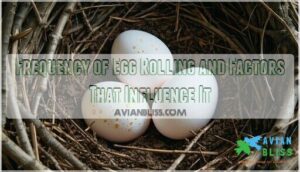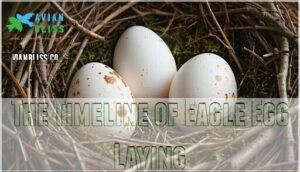This site is supported by our readers. We may earn a commission, at no cost to you, if you purchase through links.

By turning the eggs regularly, they prevent the yolk from sticking to the shell, which could harm the embryo.
This rolling also guarantees the embryo gets enough oxygen and nutrients, helping it grow properly.
They use their beaks or talons to gently nudge the eggs, like a parent fluffing a pillow for their child.
They repeat this several times a day to keep everything balanced.
It’s an essential part of their parenting, showing how even small acts make a big difference in nature, and eagle parenting is no lazy feat.
Table Of Contents
- Key Takeaways
- The Importance of Rolling Eagle Eggs
- The Rolling Process of Eagle Eggs
- Egg Rolling Behavior in Other Bird Species
- Characteristics of Eagle Eggs and Nests
- Potential Damage Caused by Egg Rolling
- Oxygen Supply Inside The Egg
- The Timeline of Eagle Egg Laying
- Incubation Period for Healthy Eagle Eggs
- What Happens When an Eagle Egg Fails to Hatch?
- How Eagles Adapt to Snowy Conditions to Keep Their Eggs Warm
- Frequently Asked Questions (FAQs)
- Why do Eagles Roll their eggs?
- Why do Eagles ball up their talons?
- How often do Eagles turn their eggs?
- Do Eagles rotate their eggs?
- How do eagles keep their eggs warm?
- Why do bald eagles abandon their eggs?
- Why do birds roll their eggs?
- What happened to Jackie and Shadow’s eggs that didn’t hatch?
- What do eagles do with their unhatched eggs?
- What is an eagle death spiral?
- Conclusion
Key Takeaways
- Eagles roll their eggs every 1-2 hours to spread warmth evenly, prevent yolk stickiness, and ensure oxygen flow.
- Rolling eggs helps embryos grow properly by improving nutrient distribution and maintaining yolk stability.
- They use their beaks or balled-up talons to gently roll the eggs without causing damage.
- This behavior is critical for healthy development and shows the precision of eagle parenting.
The Importance of Rolling Eagle Eggs
You might think eagles roll their eggs out of simple parental instinct, but this behavior serves critical biological functions that determine whether their chicks survive or die.
When eagles carefully turn their eggs every hour or two, they’re preventing the yolk from sticking to the shell membrane and ensuring even heat distribution reaches the developing embryo.
Rolling eagle eggs regularly ensures yolk stability, even heat distribution, and optimal embryo development, showcasing nature’s precision in nurturing new life.
Ensuring Proper Development and Nutrient Distribution
Nestled within its protective shell, a developing eagle embryo relies on egg rolling for even growth.
By gently turning the egg with your beak, you’re ensuring warmth and nutrients spread evenly. This movement stirs up essential fluids, improving albumen quality and nutrient absorption. It also supports yolk positioning and preserves delicate blood vessel health.
The eggs themselves are dingy white with tan tinges for camouflage. Think of egg rolling as nature’s way of stirring a perfect recipe for life.
- Promotes healthy embryo growth
- Prevents nutrient clumping
- Enhances oxygen diffusion
- Supports balanced yolk composition
Preventing Yolk Blockage and Sticking to The Embryo
Eagles roll their eggs not just for warmth but to avoid yolk adhesion risks.
Without movement, the yolk can stick to the shell membrane, harming embryo positioning and nutrient absorption.
Regular rolling, often every hour, guarantees proper membrane development and yolk positioning, which are essential egg-turning benefits.
This simple act keeps the growing chick healthy and active inside its shell.
The Rolling Process of Eagle Eggs
You mightn’t realize it, but eagles use their beaks and even their balled-up feet to gently roll their eggs with remarkable care.
Eagles delicately roll their eggs using their beaks and balled-up feet, a graceful dance ensuring warmth and life within.
They perform this every one to two hours, ensuring the embryo gets even warmth and proper development.
How Eagles Use Their Beaks to Gently Turn The Eggs
With remarkable beak dexterity, eagles demonstrate gentle manipulation by carefully turning their eggs.
This egg rolling technique avoids cracks in the delicate eggshell while distributing warmth evenly. Eagles use exceptional rolling precision, showing sensitivity to avoid harm.
Parental coordination guarantees each shift supports egg turning benefits like proper development and yolk placement. Their expertise highlights the importance of this critical egg turning practice.
The eggs, typically dingy white, benefit from this process during their 35-day incubation period, which is a crucial aspect of their proper development and overall health, influenced by the delicate eggshell.
Frequency of Egg Rolling and Factors That Influence It
Rolling frequency in eagle eggs isn’t random – it’s a science.
Eagles turn their eggs every 1–2 hours, ensuring warmth, nutrient flow, and oxygen reach every corner. Factors like egg age, clutch size, and environmental conditions shape this routine.
Here’s how it plays out:
- Colder temperatures boost egg rolling during incubation to maintain warmth.
- Denser yolks or developing embryos in older eggs require extra turning.
- Smaller clutches mean more frequent rolls per egg for nutrient absorption.
This intricate routine reveals the precision behind avian incubation. Increased turning frequency can also improve overall hatchability.
Egg Rolling Behavior in Other Bird Species
Across avian species, egg rolling is a universal expression of dedicated parental care.
Birds of all shapes and sizes, from waddling penguins to sprightly chickadees, rely on this behavior to guarantee their eggs survive and thrive.
Depending on their environment, they’ve developed clever rolling mechanisms.
Penguins, for instance, use their beaks, while chickadees shuffle eggs with their feet.
The rolling frequency varies too.
Birds in colder climates roll their eggs more often to keep them warm, while cliff-nesting species roll to prevent eggs from drifting.
These evolutionary origins highlight how diverse avian behavior adapts to challenges like temperature shifts or precarious nest sites.
Clutch size often plays a role in egg rolling habits as well.
Whether raising a single egg or a large clutch, the careful turning promotes air exchange and prevents yolk adhesion, showcasing instinctive, nurturing bird behavior.
Characteristics of Eagle Eggs and Nests
Eagle eggs, typically oval and about the size of a large goose egg, have thick shells that protect the developing chick inside.
Their massive nests, built high in trees or cliffs, are sturdy structures designed to safeguard their eggs from predators and harsh weather.
Oval Shape and Size of Eagle Eggs
Nature designed eagle eggs with care. Their oval shape and optimal egg size—typically 7–9 cm—help them roll smoothly, critical for embryo development.
Eagles carefully turn eggs to guarantee survival.
Here’s what makes eagle eggs unique:
- Creamy white shells with brown splotches offer camouflage.
- Thick, porous shells allow airflow while protecting embryos.
- The egg shape evolution balances strength and rolling benefits.
- Eagles roll eggs often, preventing abnormalities.
- Clutches typically contain 1–3 eggs, depending on environmental factors.
Features of Bald Eagle Nests
Eagle eggs are fragile treasures, and their nests are built to protect them. Bald eagles are master architects, engineering massive structures that balance strength, warmth, and comfort.
These nests can be enormous, reaching 13 feet deep and 8 feet across, crafted from sticks, grasses, and even cornstalks. Eagles prefer tall trees or cliffs, giving their homes a panoramic view and added safety.
The nests serve like cradles, their bowl shape keeping eggs centered and insulated from wind or snow. Eagles reuse these nests annually, adding fresh materials each season. This creates a sturdy, multi-generational home. Think of it as a fixer-upper project that guarantees proper nest temperature regulation while standing strong against the weather.
They often select forested areas near water to build their nests.
| Feature | Description |
|---|---|
| Nest size | Up to 13 feet deep and 8 feet wide |
| Nest materials | Sticks, grasses, corn stalks |
| Nest location | Tall trees or cliffs, often near water |
| Nest reuse | Refreshed yearly, forming multi-generational durability |
Potential Damage Caused by Egg Rolling
Handling eggs with care is essential because even subtle missteps can lead to shell cracking, internal injuries, or reduced hatching rates.
Eagles, however, are experts at egg rolling, instinctively avoiding egg rolling damage through their gentle touch. A beak that cradles rather than grips and talons that stay safely balled are part of their strategy for egg puncturing prevention.
But not everything is foolproof. Parental inexperience or sudden environmental factors, like strong winds or unstable nests, can strain even the best intentions.
Over-jostling could weaken an egg shell or disrupt the development of the delicate embryo inside. Eagles roll eggs with purpose, but these minor rolling consequences remind us that careful balance is key to ensuring the safe arrival of their chicks. Egg rolling is a delicate process that requires precision and gentle touch.
Oxygen Supply Inside The Egg
The oxygen supply inside an eagle egg plays a pivotal role in the chick’s survival.
Eggshell porosity allows oxygen to pass through tiny pores, enabling embryo respiration.
Inside the egg, the chorioallantoic membrane (CAM) acts as a delivery system, exchanging oxygen and carbon dioxide to maintain proper gas balance.
As incubation progresses, egg rolling guarantees the embryo is positioned correctly for effective membrane exchange.
Without turning, oxygen diffusion could weaken, threatening egg viability.
Altitude effects, like thin air at high nesting sites, make this process even more critical.
Egg turning promotes oxygen flow through the shell, keeps the air bubble accessible, and prevents internal blockages.
It’s amazing how nature balances such delicate systems, guaranteeing new life breathes with ease!
The Timeline of Eagle Egg Laying
After mating, it doesn’t take long—just about five days—before a female bald eagle lays her first egg.
Egg laying usually follows a pattern, with each egg appearing 1-3 days apart.
For example, in Alaska, a documented eagle laid eggs on March 15th, 18th, and 21st, completing her clutch of three.
The typical clutch size is one to three eggs, with most eagles laying two.
Laying season for bald eagles varies by region, but it’s generally from February to April.
During this period, both parents prepare the nest, carefully positioning eggs in a safe, warm spot.
Eagle egg rolling is constant throughout, optimizing heat and nutrient distribution.
Bald eagles in southern British Columbia begin their early nesting season as early as late September.
Once the clutch is complete, the focus shifts to incubation.
The male supports by hunting and even taking his turn incubating.
Without his help, the female might struggle to manage the incubation period effectively.
Incubation Period for Healthy Eagle Eggs
Timing is everything in the context of bird egg incubation, and for bald eagles, the 34-to-36-day incubation length is a fascinating balance of care and nature’s precision.
Once the eggs are laid, eagle parents work tirelessly to guarantee hatching success through proper warmth and attention.
The temperature inside the egg nest must stay between 34-40°C (93-104°F) for healthy eagle egg development. Eagles roll their eggs every 1-2 hours, guaranteeing even heat distribution and minimizing the risk of embryo sticking—a key reason for this behavior.
Humidity matters too, around 60-80%, to maintain egg viability and allow for proper gas exchange.
Care doesn’t stop there:
- Parents alternate warming duties with near-surgical precision.
- Brood patches help transfer ideal temperature directly to eggs.
- Rolling aids egg development by preventing yolk blockage.
- Gentle protection shields eggs from predators and weather.
It’s nature in its finest form, showcasing the intricate balance of proper warmth and attention that eagle parents provide to their eggs.
What Happens When an Eagle Egg Fails to Hatch?
When eagle eggs don’t hatch, it’s often due to hatch failure causes like infertility, developmental issues, or harsh weather.
Unhatched eggs may stay in the nest for weeks before parental abandonment occurs. Eagles instinctively shift focus to future seasons rather than wasting energy.
Non-viable eggs can affect nest hygiene or chick survival. Here’s a glimpse:
| Cause | Impact | Eagle Response |
|---|---|---|
| Infertility | Egg doesn’t develop | Stops incubating |
| Predation | Egg is lost entirely | Increased vigilance |
| Environmental conditions | Hatching disruption | Adjusts nesting behavior |
| Contaminated nests | Harm to future chicks | Repairs or rebuilds nest |
| Disease | Failed development | Abandons eggs |
How Eagles Adapt to Snowy Conditions to Keep Their Eggs Warm
When winter hits and snow starts piling up, eagles step into their role as nature’s ultimate caretakers.
These hardy birds have mastered the art of keeping eggs warm, even in the harshest snowy conditions. Here’s how they pull it off:
- Nest Insulation: Eagles fluff up their downy feathers and tuck eggs snugly under their brood patch—a bare, warm area on their chest—for direct heat transfer.
- Feather Insulation: Their overlapping water-resistant feathers act like a cozy blanket, ensuring snow and rain can’t seep through.
- Energy-Saving Rotations: Mom and dad take turns egg-sitting, conserving energy while ensuring warmth.
To further assist, some enthusiasts provide supplemental nest warmth during extreme cold.
Despite swirling snow and biting winds, their thoughtful behavioral adaptations, temperature regulation techniques, and efficient snow-roosting strategies keep those eggs safe and toasty until hatching day.
Frequently Asked Questions (FAQs)
Why do Eagles Roll their eggs?
Imagine tucking a baby into bed, except you’re doing it with your beak or balled feet.
Eagles roll their eggs to evenly spread warmth, prevent yolk stickiness, and guarantee proper oxygen flow for healthy development.
Why do Eagles ball up their talons?
Eagles ball up their talons when handling eggs to avoid piercing the delicate shells.
It’s like carefully cradling a fragile object, ensuring their powerful claws don’t harm the developing embryos inside.
How often do Eagles turn their eggs?
Imagine this: eagle parents are like diligent chefs turning a delicate soufflé.
They carefully roll their eggs every 1 to 2 hours, ensuring even warmth, proper oxygen flow, and healthy development for their little ones, which is a delicate process.
Do Eagles rotate their eggs?
Eagles rotate their eggs about every one to two hours using their beaks or softly balled feet.
This guarantees even warmth, proper oxygen flow, and keeps the developing embryo safe and healthy.
How do eagles keep their eggs warm?
To keep eggs warm, eagles use their brood patch—a featherless area on their chest—to transfer body heat directly.
They alternate incubation duties, maintain a cozy nest, and see that eggs stay at about 99°F.
Why do bald eagles abandon their eggs?
Bald eagles might abandon their eggs due to threats like predators, human interference, or harsh weather.
If they sense the eggs are non-viable or conditions jeopardize survival, they prioritize future breeding opportunities.
Why do birds roll their eggs?
Birds roll their eggs to evenly distribute warmth and nutrients, prevent yolks from sticking to shells, and aid oxygen exchange.
It’s like turning a cake in the oven—ensuring everything develops properly for healthy hatching, which can be considered a delicate process.
What happened to Jackie and Shadow’s eggs that didn’t hatch?
Jackie and Shadow’s eggs didn’t hatch because their development likely stopped early, possibly due to infertility or environmental factors.
Eagles often continue incubating, showing dedication, but sometimes nature takes its course despite their best efforts.
What do eagles do with their unhatched eggs?
Unhatched eagle eggs are like unopened letters from nature.
Eagles often nudge them aside or bury them in the nest lining.
Over time, these eggs decompose, blending into the nest, supporting future generations indirectly, with the process being a natural part of the ecosystem.
What is an eagle death spiral?
An eagle death spiral happens when two competing eagles lock talons mid-air, spinning downward as they fight for dominance or territory.
They usually release before hitting the ground, but it’s a breathtaking spectacle.
Conclusion
It’s almost like eagle parenting deserves an Olympic medal because rolling their eggs is no small task.
By turning them daily, eagles guarantee the embryos inside develop healthily, with proper oxygen flow and no yolk sticking to the shell.
This simple behavior answers the question, "Why do eagles roll their eggs?" Eagles safeguard their offspring using instinctual care that’s both gentle and precise.
Next time you spot an eagle, appreciate the science behind their remarkable parenting.
- https://eagles.org/what-we-do/educate/learn-about-eagles/bald-eagle-biology/
- https://journeynorth.org/tm/eagle/annual/facts_incubation.html
- https://www.pennlive.com/life/2021/02/how-do-bald-eagles-keep-their-eggs-warm-when-theyre-covered-with-snow.html
- https://www.facebook.com/RaptorResourceProject/posts/as-the-egg-turns-rolling-rolling-footingby-sherri-elliottwhile-were-eggscitedly-/1291667997536483/
- https://loudounwildlife.org/2022/03/bald-eagle-egg-not-hatch/














